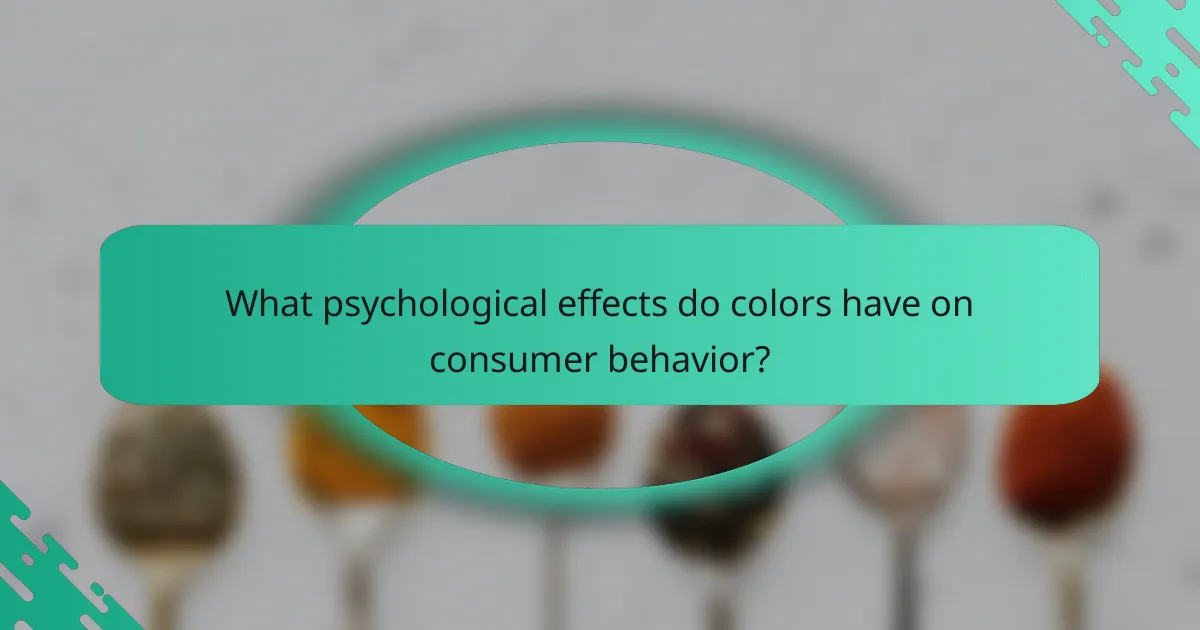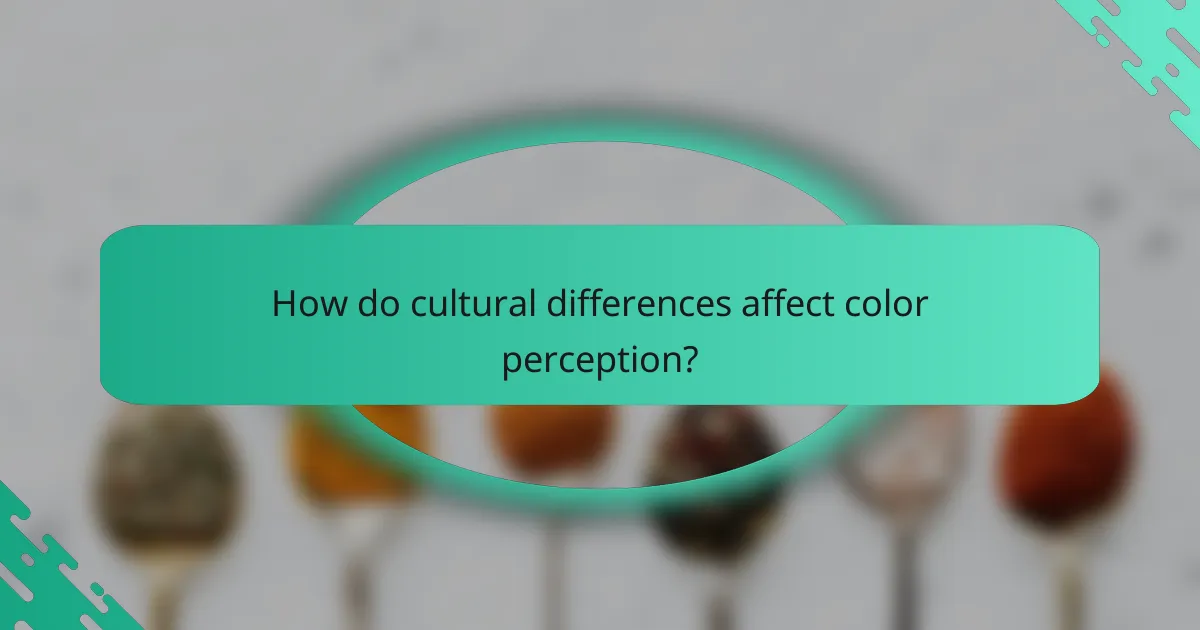Color choices play a crucial role in branding and consumer perception, as they can evoke emotions and influence purchasing decisions. By understanding the psychological impact of different hues, businesses can create effective color schemes that enhance brand identity and recognition. A thoughtfully selected color palette not only helps a brand stand out but also fosters positive associations with consumers.

How do color choices impact local business branding?
Color choices significantly influence local business branding by shaping customer perceptions and enhancing brand identity. The right colors can evoke specific emotions, improve recognition, and help a business stand out in a competitive market.
Brand recognition
Colors play a crucial role in brand recognition, as they can make a brand more memorable. Studies suggest that consistent use of color can increase brand recognition by up to 80%. For local businesses, selecting a unique color palette that aligns with their values can help them stand out in the community.
For example, a coffee shop might choose warm browns and earthy tones to evoke a cozy atmosphere, while a tech startup may opt for vibrant blues and greens to convey innovation. Consistency across all marketing materials is key to reinforcing brand identity.
Emotional connection
Color choices can create emotional connections with customers, influencing their feelings and behaviors. Different colors evoke different emotions; for instance, blue often conveys trust, while red can evoke excitement or urgency. Local businesses should consider their target audience’s preferences when selecting colors.
A restaurant might use red to stimulate appetite and encourage quick decisions, while a spa may choose soft pastels to promote relaxation. Understanding the psychological effects of colors can help businesses tailor their branding to resonate with their customers.
Market differentiation
Effective color choices can differentiate a local business from its competitors, making it more recognizable in a crowded market. By selecting colors that are distinct from those used by nearby businesses, a brand can carve out its own identity.
For example, if most local gyms use bold colors like black and red, a fitness studio might choose softer shades like teal or lavender to appeal to a different demographic. This differentiation not only attracts attention but also communicates the unique values and offerings of the business.

What psychological effects do colors have on consumer behavior?
Colors significantly influence consumer behavior by evoking emotions and perceptions that can drive purchasing decisions. Different hues can create associations that affect how a brand is perceived, impacting everything from trust to urgency.
Color associations
Colors carry specific associations that can vary by culture and context. For instance, blue often conveys trust and reliability, making it popular among financial institutions, while red can evoke excitement or urgency, frequently used in clearance sales. Understanding these associations helps brands align their color choices with their desired message.
In marketing, utilizing color psychology can enhance brand recognition and emotional connection. For example, green is commonly associated with health and sustainability, appealing to environmentally conscious consumers. Brands should consider their target audience’s cultural background when selecting colors to ensure the intended message resonates.
Decision-making influence
Colors can significantly influence decision-making processes by affecting mood and perception. Warm colors like orange and yellow can create a sense of urgency, encouraging quick decisions, while cooler colors like blue and green tend to promote calmness and deliberation. This can be particularly effective in retail environments where impulse buying is desired.
To leverage color effectively, brands should test different color schemes in their marketing materials and product displays. A/B testing can reveal which colors lead to higher conversion rates. Additionally, ensuring that color choices align with the overall brand identity can enhance consumer trust and loyalty.

How can businesses choose effective color schemes?
Businesses can choose effective color schemes by understanding their target audience, adhering to industry standards, and applying color harmony principles. A well-selected color palette can enhance brand recognition and influence consumer behavior positively.
Target audience analysis
Understanding the target audience is crucial for selecting an effective color scheme. Different demographics may respond to colors in unique ways based on cultural backgrounds, age, and gender. For example, younger audiences might prefer vibrant colors, while older consumers may lean towards muted tones.
Conduct surveys or focus groups to gather insights on color preferences among your target market. This can help tailor your color choices to resonate more deeply with potential customers, ultimately driving engagement and sales.
Industry standards
Each industry often has established color conventions that can guide businesses in their color scheme choices. For instance, blue is commonly used in finance for its associations with trust and stability, while green is prevalent in health and wellness sectors for its calming effects.
Research your industry’s color trends and consider how your brand can align with or differentiate from these norms. This balance can enhance brand recognition while ensuring that your color choices are contextually appropriate.
Color harmony principles
Applying color harmony principles can create visually appealing and effective color schemes. Techniques such as complementary, analogous, and triadic color schemes can help achieve balance and cohesion in design. For example, a complementary scheme uses colors opposite each other on the color wheel, creating a vibrant contrast.
When selecting colors, consider the emotional impact they convey. Warm colors like red and orange can evoke excitement, while cool colors like blue and green can promote calmness. Aim for a palette that not only looks good but also aligns with your brand message and values.

What are the aesthetic trends in color choices for 2023?
In 2023, aesthetic trends in color choices emphasize boldness and minimalism, reflecting a desire for both vibrancy and simplicity. Designers are increasingly using striking color palettes alongside clean, understated designs to create impactful visual experiences.
Bold color palettes
Bold color palettes are characterized by vibrant, saturated hues that capture attention and evoke strong emotions. In 2023, expect to see combinations of bright reds, deep blues, and vivid yellows, often used in unexpected pairings to create dynamic contrasts.
When utilizing bold colors, consider the psychological impact they can have on viewers. For instance, red can evoke excitement, while blue often conveys trust. Striking a balance between boldness and harmony is crucial, so aim for a limited palette of three to five colors to maintain cohesion.
Minimalist designs
Minimalist designs focus on simplicity, using a restrained color palette to enhance clarity and functionality. In 2023, this trend often incorporates soft, muted tones like pastels or earth tones, which promote a sense of calm and sophistication.
To effectively implement minimalist designs, prioritize whitespace and clean lines, allowing colors to stand out without overwhelming the viewer. Avoid clutter by limiting the number of colors and elements on the page, which can help create a more focused and engaging user experience.

How do cultural differences affect color perception?
Cultural differences significantly influence how individuals perceive and interpret colors. Factors such as traditions, beliefs, and social norms shape the meanings associated with various colors, leading to diverse interpretations across different cultures.
Regional color meanings
Colors can carry distinct meanings in different regions. For example, in Western cultures, white is often associated with purity and weddings, while in some Eastern cultures, it symbolizes mourning and funerals. Understanding these regional meanings is crucial for effective communication and design.
Another example is red; in China, it signifies good fortune and joy, whereas in South Africa, it can represent mourning. When designing products or marketing strategies, consider these regional interpretations to avoid cultural missteps.
Global branding considerations
When creating a global brand, it’s essential to consider how color choices will be perceived in various markets. A color that resonates positively in one country may have negative connotations in another, affecting brand perception and customer engagement.
For instance, while blue is often seen as trustworthy and professional in many Western countries, it can be viewed as cold or uninviting in some cultures. Brands should conduct thorough research and possibly engage local experts to ensure their color schemes align with cultural expectations.

What tools can help with color selection for local services?
Several tools can assist in color selection for local services, helping businesses create appealing and effective branding. These tools offer features like color harmony, palette generation, and user-friendly interfaces to simplify the design process.
Adobe Color
Adobe Color is a powerful online tool that allows users to create and explore color schemes based on various color rules, such as complementary or analogous. Users can start from scratch or upload an image to extract a palette, making it versatile for different design needs.
When using Adobe Color, consider the target audience and local culture, as colors can have different meanings in different regions. For example, while blue may convey trust in many Western cultures, it might have different connotations elsewhere.
Coolors
Coolors is a fast and intuitive color scheme generator that enables users to create, save, and share palettes with ease. Users can lock in colors they like and generate new combinations, allowing for quick experimentation.
A key feature of Coolors is its accessibility across devices, making it easy to use on-the-go. When selecting colors, think about how they will appear in various formats, such as print versus digital, to ensure consistency in branding.
Canva Color Palette Generator
The Canva Color Palette Generator is a user-friendly tool that helps users create color palettes from images or by choosing colors manually. It provides a straightforward interface and is particularly useful for those who may not have a design background.
To make the most of Canva’s tool, consider the emotional impact of colors on your audience. For local services, aligning your color choices with community values can enhance brand recognition and customer loyalty.

How can color choices enhance customer experience?
Color choices can significantly enhance customer experience by influencing emotions and perceptions. Carefully selected colors can attract attention, convey brand identity, and create a positive atmosphere, ultimately leading to increased customer satisfaction and loyalty.
Visual appeal
Visual appeal is crucial in attracting and retaining customers. Colors can evoke specific feelings and associations; for instance, blue often conveys trust, while red can stimulate excitement. Choosing the right color palette can make a product or service more visually appealing and memorable.
When designing marketing materials or a website, consider using color combinations that complement each other and align with your brand’s message. Tools like Adobe Color can help in selecting harmonious color schemes. Aim for contrast to ensure readability and draw attention to key elements.
Be mindful of cultural differences in color perception. For example, while white is associated with purity in many Western cultures, it may symbolize mourning in some Eastern cultures. Understanding these nuances can help tailor your color choices to resonate with your target audience effectively.


